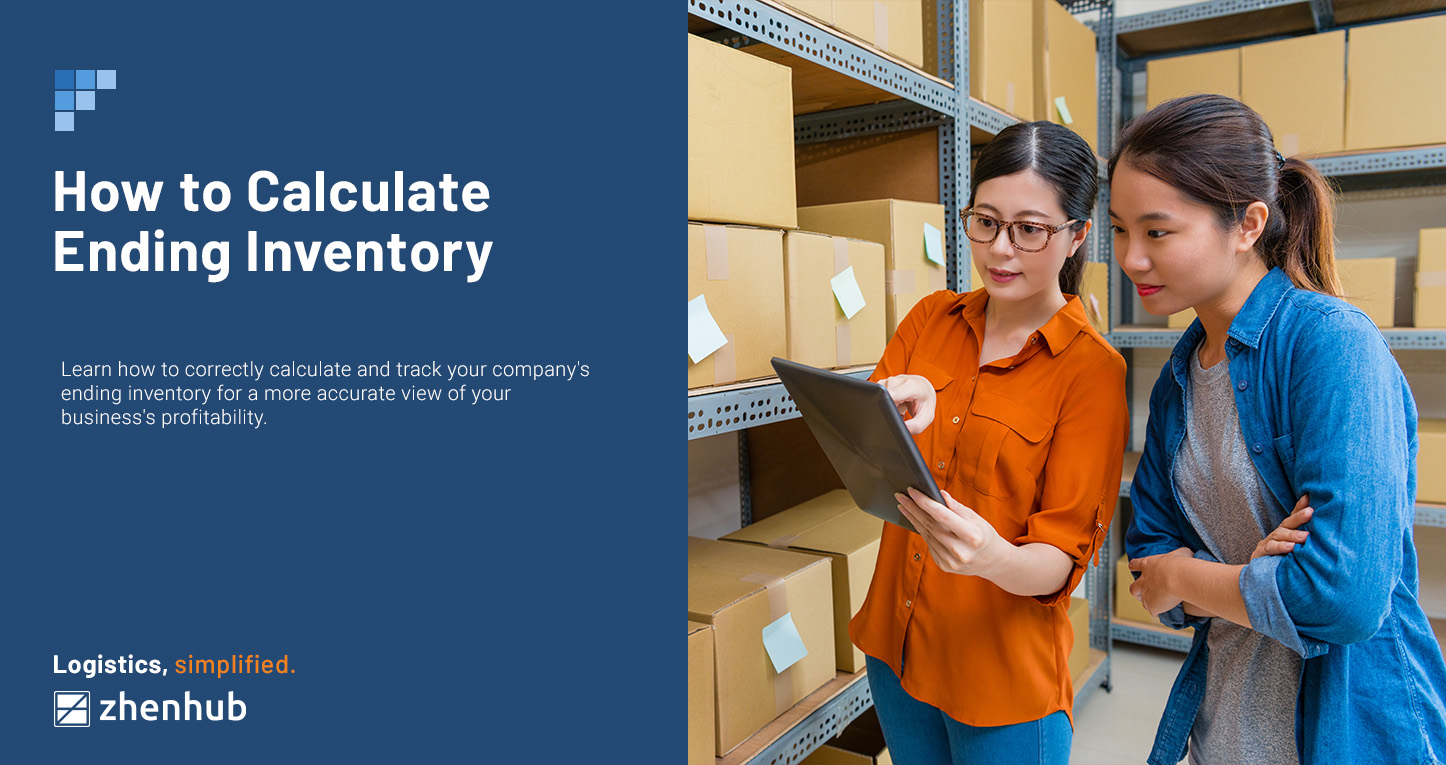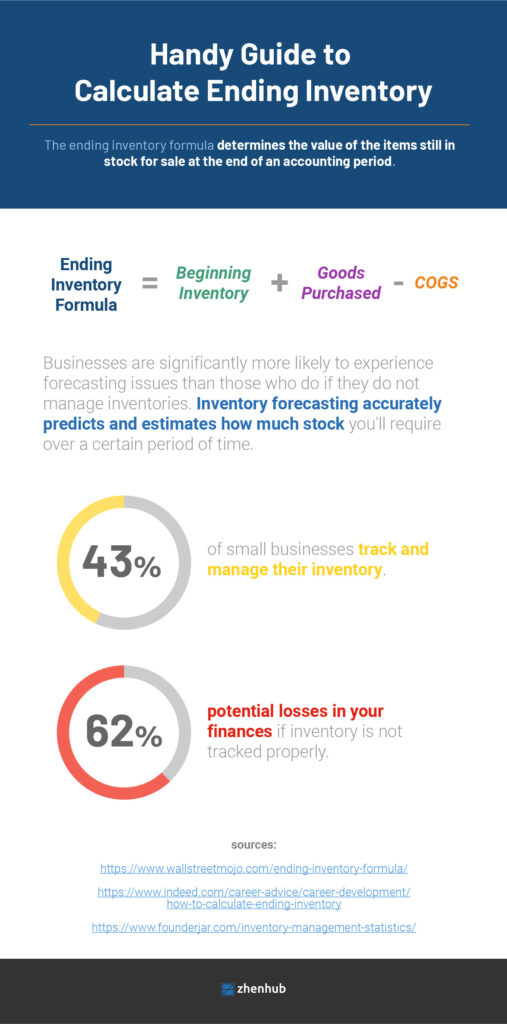
How to Calculate Ending Inventory
Time to read: 6 minutes
Businesses of all kinds, retail or online eCommerce, will have come across the term-ending inventory. Learning how to calculate it is practically a requirement to be successful.
By reading through this article, determine how much saleable stock you have left to sell after a specific accounting period.
Knowing your ending inventory is crucial for inventory accounting. It might be challenging for many to figure out how much sellable stock you have on hand after an accounting period. Forty-three percent (43%) of small businesses aren’t tracking their inventory, meaning many entrepreneurs aren’t fully optimizing their operations.
The entire value of the items you have in stock for sale at the end of an accounting period, such as your fiscal year, is known as ending inventory. An inventory accounting technique aids merchants in precise stock inspections, financing applications, and net income benchmarking.
The simplest way to calculate ending inventory is to add new purchases to the beginning list (your stock at the start of a period) and then deduct the cost of products sold (COGS). This is called the ending inventory formula.
Calculate Ending Inventory: The Formula

Beginning Inventory + goods purchased – COGS = Ending Inventory
For example, if your initial inventory is worth $10,000 and you spent $5,000 on new goods, you now have a total of $15,000 item value in the stock. You managed to sell $12,000 worth of goods. Your final inventory would be $3,000.
A physical inventory count can produce a more accurate ending inventory. However, this is frequently impractical for larger enterprises. Inventory counts are easier through improvements in inventory management software and RFID systems. Other technologies utilizing linked devices and platforms can also make it easier.
Understanding How to Calculate Ending Inventory
Have better control and oversight of your stock-related and financial decisions when you are aware of your ending inventory.
Calculating ending inventory can be done in several different ways. Your chosen strategy will impact several operations and activities, including budgeting, reordering amounts, and increasing profit.
It’s crucial to stick to your chosen method. Using several ending inventory computations simultaneously could result in inaccurate financial reports. So spend time deciding which approach will work best for your business, and stick with it.
1. FIFO Method (first in/first out)
FIFO assumes that your company’s oldest purchases were utilized to create the products sold first. Simply put, this technique implies that the first products ordered will be the first to be sold. When using FIFO, the cost of the most recent purchases is added to the ending inventory. This value is still available at the end of the period, while the cost of the oldest purchases is added to COGS first.
To help illustrate this, let’s assume you start out with ten (10) items purchased at $25. Then several months later, you bought another 10 of the same item at $30. If those 20 items are available and sell seven (7) of them, the FIFO method says that you unload the items that were first bought for $25. This amounts to a $175 cost of goods sold.
Thus the ending inventory would be calculated as follows:
$250 (beginning inventory) + $300 (new goods purchased) – $175 (COGS) = $375 ending inventory
2. LIFO Method (Last in/first out)
This approach is the opposite of the previous method. The LIFO system operates under the idea that the last-purchased products are sold. Using the same example above, the calculation for ending inventory is quite different. The (seven (7) items sold would now be calculated for the $30 cost, as they were the products stocked most recently.
$250 (beginning inventory) + $300 (new goods purchased) – $210 (COGS) = $340 ending inventory
It’s important to remember that applying the LIFO technique during periods of inflation might lead to lower net income values. It could also lower the final inventory value.
3. Weighted average cost method (WAC)
For WAC, you take the total amount you spent on inventory and divide it by the quantity. It “weighs” the average since it accounts for the volume of goods bought at various price points.
Imagine your business has an inventory of 100 goods valued at $2.50 when the accounting year starts. Then, you spend $3.50 on 300 more goods. Thus, the total value of the inventory is $250 + $1050, which comes to around $1300. The weighted average is $3.25 when you divide this by 400.
Why It’s Important to Calculate Ending Inventory
Your closing inventory balance is more than just a metric to monitor after the fiscal year. Consider using this strategy to value your goods all year long. Be aware of how much you’re selling as well as how much you’re not. Until it gets sold, eCommerce inventory is merely another expense. Calculating ending inventory is an excellent practice for businesses in eCommerce and a crucial step in the accounting procedure.
1. Inventory Tracking Accuracy
The numbers on your inventory balance sheet must correspond to the actual number of items in your warehouse. Knowing your ending inventory let’s confirm what’s physically on hand, check out with the inventory you have recorded. Inventory shrinkage might result from theft, accounting error, or many other problems.
Accurate inventory counting aids in budgeting for open-to-buy purchases as well. If you have $6,000 worth of unsold goods, then investing $10,000 in stock replenishment makes little sense. If unsold items are in your stockroom, adjust your strategy with the right data. Also, don’t order too much safety stock; a well-organized stockroom may help with this problem.
2. Calculates Net Income
One of the most crucial financial indicators for businesses to track is net income. It’s the money in your account after you’ve paid for expenses, staff wages, taxes, and production costs over a specific time. It’s often the final amount displayed on an income statement.
Compare the value of your ending inventory to your net profit . Doing this lets you check if you are overpaying for supplies or underpricing merchandise.
If your ending inventory numbers don’t match up, you are keeping more money in inventory than you have made in sales. Stock overpayment can become a major problem for your organization. Consider negotiating costs with suppliers or raising pricing for your products to get a better net income-to-ending inventory ratio.
3. Improves Reporting and Forecasting
Recall how the beginning inventory is a crucial element to calculate ending inventory. It also works the other way. The ending stock of the previous accounting period is used to compute the beginning inventory of the current period. The ending balance of the preceding reporting period is used to calculate the beginning balance. Your balance sheet must reflect the accurate ending inventory calculation.
Using the same methodology each year is best when calculating ending inventory, preventing inconsistencies in your reporting. Getting your business prepped for growth begins with a previous understanding of performance. It’ll help influence strategies to improve.
If your ending inventory and financial transactions are in line, it becomes possible to assess how well your company has stuck to its yearly budget. Comparing these two metrics makes it easier to identify any obvious manufacturing cost issues. These are especially important when determining the parameters for inventory forecasting.
Keep in mind that ending inventory is carried over to the new accounting period. The economic effects of an erroneous stock value measurement would therefore carry over into the subsequent accounting period.
The Business Impact When You Properly Calculate Ending Inventory
For any business owner, inventory is crucial to success and significantly influences financial accounts. If the ending inventory is incorrectly tracked, it might affect your business’s profitability in various ways. As a result, keeping the inventory right should be one of your top responsibilities. Supply Chain Digest suggests that eliminating stock-outs and overstocks may cut total inventory costs by up to 10%. That’s a sizable sum of money for any organization.
Between the amount of inventory recorded in records and the value of the actual stock stored, there can be inventory discrepancies.
COGS are deducted from sales to determine gross profit. That means changes in COGS will directly affect a company’s financial statements. Gross profits will increase if inventories are exaggerated and decrease if inventories get understated.
Instead of reflecting the actual physical stock levels, overstated inventory records will show that there is more inventory stock kept. Theft, damage, fraud, wrong inventory counts, and administrative mistakes can all contribute to this difference.
Surplus stock in the accounting records results in a higher closing stock and lower COGS. Overstating inventories decreases the actual cost of goods sold. Current assets, total assets, and retained earnings all tend to be exaggerated when ending inventory is understated.
Mistakes will affect subsequent quarters if the overstatement of closing inventory is not addressed afterward. However, a correction will also impact the cost of products sold. Except for this time, it will go the other way. When the inventory is adjusted, the cost of products sold is misrepresented as being higher than it is. As a result, the business may appear less lucrative than it is. Investors could develop unfavorable impressions of your firm as a result.
It’s in your best interests to keep a close eye on your ending inventory. Correctly calculating it helps your business perform better and comply with legal and ethical business practices.
ZhenHub can assist in calculating your ending inventory with high-tech digital solutions such as inventory management software and multi-channel fulfillment. Always keep your stock in check when you sign up to ZhenHub.